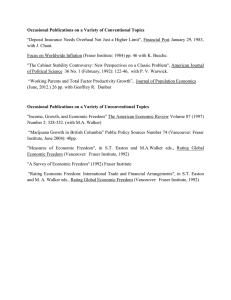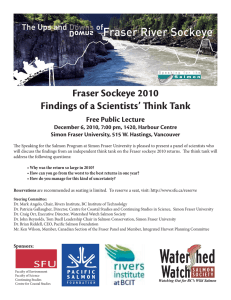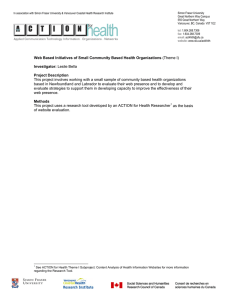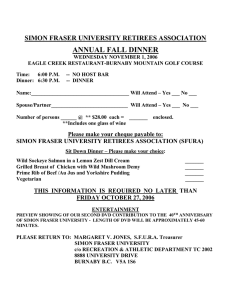Document 13582675
advertisement
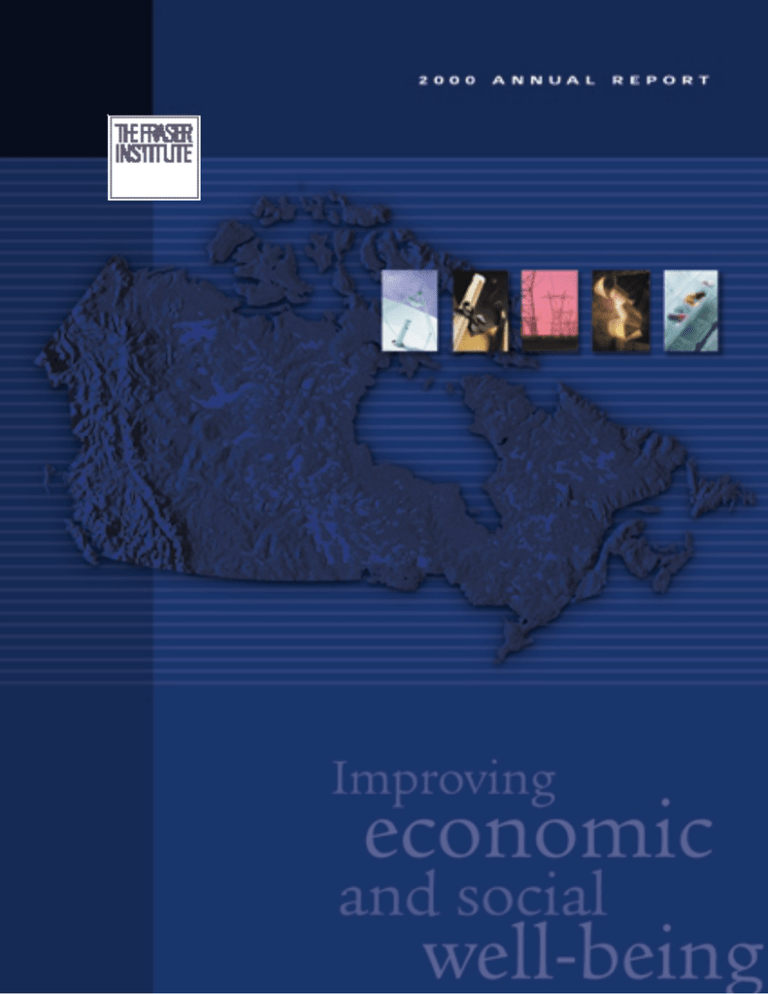
THE FRASER INSTITUTE IS AN INDEPENDENT CANADIAN ECONOMIC AND SOCIAL RESEARCH AND EDUCATIONAL ORGANIZATION. IT HAS AS ITS OBJECTIVE THE REDIRECTION OF PUBLIC ATTENTION TO THE ROLE OF COMPETITIVE MARKETS IN PROVIDING FOR THE WELL-BEING OF CANADIANS. WHERE MARKETS WORK, THE INSTITUTE’S INTEREST LIES IN TRYING TO DISCOVER PROSPECTS FOR IMPROVEMENT. WHERE MARKETS DO NOT WORK, ITS INTEREST LIES IN FINDING THE REASONS. WHERE COMPETITIVE MARKETS HAVE BEEN REPLACED BY GOVERNMENT CONTROL, THE INTEREST OF THE INSTITUTE LIES IN DOCUMENTING OBJECTIVELY THE NATURE OF THE IMPROVEMENT OR DETERIORATION RESULTING FROM GOVERNMENT INTERVENTION. THE WORK OF THE INSTITUTE IS ASSISTED BY AN EDITORIAL ADVISORY BOARD OF INTERNATIONALLY RENOWNED ECONOMISTS. THE FRASER INSTITUTE IS A NATIONAL, FEDERALLY CHARTERED NON-PROFIT ORGANIZATION FINANCED BY THE SALE OF ITS PUBLICATIONS AND THE TAX-DEDUCTIBLE CONTRIBUTIONS OF ITS MEMBERS, FOUNDATIONS, AND OTHER SUPPORTERS. Head Office 4th Floor, 1770 Burrard Street, Vancouver, British Columbia, Canada V6J 3G7 Telephone: (604) 688-0221, Fax: (604) 688-8539 E-mail: info@fraserinstitute.ca, Web site: www.fraserinstitute.ca Membership: 1-800-665-3558, ext. 586 Book Orders: 1-800-665-3558, ext. 580 To ro n t o O f f i c e Telephone: (416) 363-6575, Fax: (416) 601-7322 Calgar y Office Telephone: (403) 216-7175, Fax: (403) 234-9010 Chairman’s Report IT IS A GREAT PLEASURE TO REPORT ON THE ACTIVITIES OF THE FRASER extent to which the considerable effort expended in the education system actually INSTITUTE DURING ITS 26TH YEAR OF OPERATION. EVEN MORE THAN USUAL, produces an increase in the knowledge output from the system. One of the difficulties THE EXTENT OF THOSE ACTIVITIES IS SUCH THAT I CAN DO LITTLE MORE, IN MY in this regard was the lack of a focus on performance measurement and the MESSAGE, THAN WHET YOUR APPETITE FOR THE FULL CONTENTS OF THE ANNUAL comparative assessment of how schools were actually succeeding in adding value to REPORT. AS IT HAS DONE IN PREVIOUS YEARS, MY REPORT WILL FOCUS ON ONE the student intake. ACTIVITY WHICH ROSE TO PROMINENCE DURING THE YEAR. Developing the Department of School When he spoke to The Fraser Institute’s Annual Meeting in 1994, Nobel Laureate Per formance Studies Professor Milton Friedman noted that we were in the grip of a second industrial In 1997, The Fraser Institute determined to remedy this perceived deficiency. We revolution, a revolution based on the intensive use of knowledge. Those nations that set as our first objective the measurement of the performance of all of Canada’s high best used their intellectual capacities would dominate the future industrial landscape. schools. In this endeavour we were very fortunate to attract the interests of two Thus, Professor Friedman noted, the crucial industry for every country in the world researchers who have proved to be crucial in the project’s overall success. Professor is its education industry. Those countries that had an effective education industry Stephen Easton had written our 1988 book, Education in Canada, which articulated infrastructure would sooner or later come to dominate those that did not. some of the difficulties with the primary and secondary education system. It was Of course, educational capacity is not the only determinant of industrial success. natural for him to have an interest in the project. Indeed, Professor Friedman has been at the forefront of advancing the importance of The other person who would prove to be key to the development of this project was property rights and an infrastructure of rule by law in setting the stage for economic Mr. Peter Cowley. Peter was first attracted to the issue of high school performance development. But there can be no doubt that the effectiveness of a nation’s educational assessment by observing his own child’s experience with the system. He also had a infrastructure must be a key determinant of its future success in an information- curiosity about performance measurement stemming from his involvement in dominated world. In respecting the importance of education, The Fraser Institute industrial sales and marketing. has long had a focus on the educational sector. More than 15 years ago, the Institute undertook a comprehensive overview of Canada’s elementary, secondary, and post-secondary educational apparatus to examine the incentives that its participants The technology for the project came from the international Economic Freedom of the World project, which had, over many years, researched and devised a method for measuring and comparing the performance of national governments. faced, and how these incentives would impel the education system forward. The most important obstacle which the project would have to overcome was the One of the things that those studies noted, particularly in the primary and secondary schools, was the lack of systematic attention to the issue of value adding. That is, the attitude of the participants in the educational process. The most prevalent attitude is that a child’s performance in high school is predominantly and overwhelmingly determined by socio-economics, not by the school’s performance as a value-adding enterprise. The typical story goes something like this: “A child’s performance is determined almost entirely by the luck of their socio-economic draw in life. People of a particular socio-economic type tend to cluster in the catchment area for particular schools, and there is no point in drawing attention to the fact that these schools under-perform because they are drawing from under-performing populations.” I had a personal experience early last year which demonstrated to me very clearly that this attitude is entirely incorrect. On the contrary, a school and the teachers who run it can have a profound impact on the achievement of children. During a trip to England, I chanced upon a newspaper account of the spectacular impact which one woman, Sharon Hollows (now Dame Sharon Hollows), had on the success of a school that draws its children from one of the least advantaged areas in Britain. Five years previously, as the recently-appointed principal of Calverton Primary School Gary Wildman Fraser Institute Chairman of the Board of Trustees, Mr. Raymond Addington, O.B.E., prepares to address members at The Fraser Institute Annual General Meeting on April 3, 2000. in London’s East End, Sharon Hollows found that her school had just been ranked as one of the lowest-performing elementary schools in Britain. She was embarrassed and humiliated by the poor showing, but was determined to change it. And what a magnificent job she did! Currently, Calverton School is a “Beacon School” in Britain, T h e F r a s e r I n s t i t u t e 2 0 0 0 A n n u a l R e p o r t 1 Chairman’s Report which means that the government encourages teachers from across the country to performance. Early editions of the Report Card also provided an opportunity to go there to see how a truly successful school is organized. From the bottom of perfect both the research methodology and the dissemination of the results. the heap to the top in four short years—and all the while working with children The distribution has been a critical factor, since we want to ensure that every educator, from broken homes, racial minorities, other languages, hostile parents, 50 percent parent, and child in the province has access to the results. Accordingly, in each unemployment, etcetera. province we have chosen to partner with a widely-distributed newspaper or magazine. As Dame Hollows herself has said, the measurement of school performance and the In British Columbia, we chose the Province, the newspaper with the largest circulation resulting rankings that showed how poorly her school was doing was an essential in BC, and readership demographics appropriate to our goal. ingredient in her ultimate success since it motivated her to implement the changes The Province devoted some seventeen pages over four days to presenting the first which have produced the dramatic turn around. edition of A Secondary Schools Report Card for British Columbia, including results for The intent of The Fraser Institute Department of School Performance Studies is to almost every school in the province. Community newspapers were quick to respond improve the educational outcomes of our schools by providing to every educator, with their own coverage. The impact could not have been more dramatic as principals, every parent, and every child in the country, documentation of how well they are teachers, politicians, students, radio talk show hosts, journalists, and especially doing relative to their peers. While much remains to be done to achieve that goal, parents, reacted strongly to the ranking of their schools. a surprisingly large amount has already been accomplished. The Chairman of a newly-formed private school threatened legal action because of An annual report card on secondary schools was introduced in British Columbia, the effect the low ranking would have on his school’s ability to retain the students where some 280 high schools have now been ranked four times. Using data reaching whose fees were necessary to fund their outstanding debt. Subsequently he extolled back eight years, the Report Cards give a comprehensive view of the academic the virtues of the ranking program since it caused his school to assess and change performance of schools relative to each other, and relative to their own past some of the school’s key personnel. Gary Wildman 1999 Nobel Laureate in Economics Dr. Robert Mundell (centre) joins some members of The Fraser Institute Board of Trustees at the Institute’s Annual General Meeting on April 3, 2000 in Vancouver. In photo from left: Mr. Bob Lee, Dr. Michael Walker, Mr. Brandt Louie, Mr. Herb Pinder, Jr., Dr. Robert Mundell, Mr. Michael Hopkins, Mr. Raymond Addington, O.B.E., Mr. T. Patrick Boyle, Mr. John R. Graham (staff), Mr. Ev Berg, Mr. Paul Hill, Mr. Bill Korol, and Mr. Arthur Grunder. 2 Chairman’s Report The “educational establishment” in government schools was generally less receptive to the idea of performance assessment than those in independent schools. In fact, there was a determined effort in the former to denigrate the report, deny its importance, or simply ignore it—that is, until the reaction of parents and students had become fully evident. Once it became clear that there was widespread public interest, that parents wanted answers for poor performance, and that we were intent on doing this sort of measurement every year, the attitude changed. After publication of the second Report Card on British Columbia’s Secondary Schools, the principal of the lowest-ranked school in the province thanked us,“in the way a patient thanks a dentist for a root canal” and went on to note that the Report Card “was the greatest leadership experience of my life.” The performance measurement project has come a long way since that first report card was released in BC in 1998. To date, Alberta, Quebec, and BC secondary schools are now annually assessed and ranked. In 2001, Ontario will be added. In Alberta Magelle’s Photographers we partnered with the Calgary Herald and the Edmonton Sun. In Quebec, L’Actualité Principal Sharon Hollows from Calverton, one of London’s tougher primary schools, gave a stirring keynote address at the W. Garfield Weston Outstanding Principals Awards ceremony held in both Calgary and Vancouver in October 2000. magazine worked with us and our Quebec-based sister organization, L’Institut Économique de Montréal along with Le Journal de Montréal and the Montréal Gazette, to blanket that province. In 2001 in Ontario, the National Post will run a special section in each of their four separate regional editions with the results of the schools in those regions. The most direct evidence that the Report Cards are making a difference, however, is in the changing attitude of the principals themselves. In conjunction with the recent release of the 2001 Report Card on British Columbia’s Secondary Schools, the Province newspaper made a point of talking with the principals of some of the province’s schools. In particular, reporters interviewed the principals of two schools, David In all, almost 1,000 high schools have been rated and ranked. Our major media partners alone have devoted over 200 pages to the reports—coverage which would have cost almost $2,500,000 had we to purchase it as advertising copy. And, there is an increased interest in doing more with the reports. Thompson Secondary and John Oliver School, which draw their students from the same city centre population, but which have radically different performances. On average, over the past five years, David Thompson ranked 51st while John Oliver ranked very poorly at 229th. Ian McKay, the principal of John Oliver, told the reporter In Quebec, for example, L’Actualité plans, in the Fall of 2001, to print and distribute that the school “treated its poor performance ratings as a wake-up call: ‘It was a call with its magazine a separate publication containing the detailed Quebec results. It is to us to look at the kinds of kids we were serving and what we need to do for them.’” easy to understand their interest in doing so since parental response in that province has been profound. One indicator of the interest is the extent to which the Report Card has caused parents to seek alternatives to the public schools their children now attend. The comparative performance of these two schools in Vancouver echoes the Sharon Hollows story, and indeed the results of our research on the performance of schools across Canada. That is, school performance is not pre-determined by the population In a front page story, Le Devoir newspaper reported that the requests for admission from which the students are drawn. A school and its educators can make a very to private schools were increasing dramatically. The reason given for the surge in significant difference in pupils’ lives—the difference between being on the bottom applications was the recently-released Fraser Institute Report Card on the performance of the pile, or on the top. of Quebec’s high schools. Parents were seeking private schools for their children because they had discovered that the government schools their children had been attending were under-performing. Of course, all of the people who work at a successful school contribute to its success. But the CEO is in a position to make the difference, and for that reason it is often the school’s principal who deserves the recognition when a school does well. In recognition From the point of view of what the Department of School Performance Studies is of that fact, and as a natural complement to the performance-rating program, the trying to accomplish, increased enrolment in private schools is only one possible Institute has also launched, in conjunction with the W. Garfield Weston Foundation, outcome. The most widely felt outcome will undoubtedly be an improvement in the the W. Garfield Weston Outstanding Principals Awards Program. conduct of government-controlled schools. Certainly there are already indications of that effect in the form of invitations from school districts to make presentations to superintendents and principals about the performance measurement system. Initially, this program has rewarded outstanding principals in British Columbia and Alberta, but it is hoped eventually to extend the program to include the other provinces in which we are able to measure the performance of schools. It gave me enormous pleasure to be able, at the inaugural award ceremony in Calgary, to introduce Dame Sharon Hollows, who gave the keynote address at the event. T h e F r a s e r I n s t i t u t e 2 0 0 0 A n n u a l R e p o r t 3 Chairman’s Report The Garfield Weston Outstanding Principals Awards recognize three sorts of Health Care accomplishment by principals: the top scoring school, the most improved school, One subject that has surged to public attention during the last year is the decay of and perhaps most importantly, the school which does best relative to its expected the health care system. A centrepiece of the discussions has been the Institute’s performance given the socio-economic characteristics of the students who attend. annual survey of hospital waiting lists. Since this 12-year long project provides the The characterization of the schools is possible because, with the assistance of Statistics only nationally comparable source of information on waiting in the provinces, it is Canada’s census data, we have been able to create a micro socio-economic context understandable that it has been much mused about and abused during the year. for each school. We have the postal code for every student who attends school; a cross-match between these postal codes and the census information produces the data we need, from family income to the language spoken in the home, to establish the schools’ socio-economic composition. In 2000, for the first time, it was possible for the Institute to relate these measurements of waiting to the amount of money spent in the provinces. The results were quite astounding since they showed that there is no connection between the amount of money a province spends on health care and the length of time a province’s resident On the wall of the Institute’s boardroom there is a plaque given to the Institute by has to wait for that care. In fact, there isn’t even a connection between the money long-time Trustee Mr. Fred Mannix. The plaque says,“If it matters, measure it.” spent and the quantity of health care services produced. In some sense, this sentence conveys the spirit of the work of The Fraser Institute, which is to change the climate of opinion by disseminating research results based on a careful measurement of things that matter. The School Performance Studies Department is a particularly good example of how the Institute uses measurement to change the world. The results of this study have been seized upon across Canada and there is now widespread acknowledgement that the problems of our health care system do not emerge primarily from a lack of money. In fact, Michael Decter, Chairman of the Board of the Canadian Institute for Health Information, a long time advocate of the Canadian health care system, noted upon the release of Dr. Martin Zelder’s study Of course, the School Performance Studies Department is not the only department that everyone knew that more money would not produce solutions to the health care at the Institute, and I want to mention a few other areas where the Institute has been problems. Rather, the structure of incentives would have to change. We can only making effective use of measurements to pursue its goals. wonder were he might have got such a sensible idea. Gary Wildman Giving the fifteenth annual Dr. Harold Walter Siebens Lecture: Nobel Laureate Dr. Robert Mundell tells a packed house about “Exchange Rates & Monetary Unions and their Relevance to Canada” at The Fraser Institute’s Annual General Meeting in April 2000. 4 Chairman’s Report Alberta Initiative The Fraser Institute’s Alberta Initiative took shape during 2000 as we greatly expanded the scope and function of the Institute’s Calgary office. Dr. Lydia Miljan has spearheaded this expansion which has amplified the ability of the Institute to deal with issues of particular relevance to Albertans. It has also expanded our capacity to deal with issues of political economy as we have been able to encourage the members of the “Calgary School” of Political Science to join with our efforts.We are delighted to have Senior Fellows Professor Barry Cooper, Professor Tom Flanagan, Professor Ted Morton, Professor Rainer Knopff, Professor Ken Mackenzie, Professor Ron Kneebone, Professor Herb Emery and Professor Eugene Beaulieu working on a variety of projects. Gary Wildman Nobel Laureate Dr. Robert Mundell (right) listens to Fraser Institute Trustee Mr. Ev Berg (centre) and Mr. Bill Korol prior to The Fraser Institute’s Annual General Meeting in April, 2000. C a p i t a l G a i n s Ta x a t i o n We have already seen the impact of this involvement in the area of environmentalism and the Alberta Advantage Surveys. Fraser Forum This year also saw some important changes in our flagship monthly publication, Another measurement activity during the year proved quite influential. The annual Fraser Forum. Under the direction of Ms. Kristin McCahon, our Director of Dobson Foundation Conference on Taxation under the leadership of Sommerville Publication Production, Fraser Forum has been transformed, and is now poised to Chair Dr. Herbert Grubel focused this year on the topic of capital gains taxation. The become a broad circulation periodical replete with advertising, glossy stock, representatives of 10 countries in which there are no, or very modest, capital gains and superlative content. We have every reason to be extremely proud of this widely- taxes participated. The upshot of the private conference, which was well attended by read magazine. senior government officials, was that there do not appear to be any adverse side Head Office effects from eliminating capital gains taxes altogether. We were pleased to see that the message was not lost on the federal Finance Department as it formulated the content of the mini-budget in October. Sur vey of Senior Investment Managers One of the influential products under the direction of Mr. Jason Clemens, which the Centre for Fiscal Studies has been producing for the past 7 years, received an interesting endorsement during the year. The quarterly Survey of Senior Investment Managers collects the opinions of money managers managing nearly $200 billion in assets. The opinions of these managers about the policies of provincial and federal governments are quite influential; these people are the most important purchasers of government bonds and have the power to reward and punish governments—particularly sub-national governments—when they approve or disapprove of those governments’ actions. In 2000, the Investment Dealers Association joined with the Institute to sponsor the survey and to work with us to increase the number of managers responding to the survey. One of the most pleasant developments during the year has been the expanded use of our new head office building for a variety of meetings, special guest speakers, and training sessions. During the year we hosted some 20 events in our meeting room which would otherwise have been held in hotels. The meeting room has also been used for our weekly Policy Lunch. The overall experience with our new premises has been very positive and staff productivity has increased appreciably. In addition, a recent real estate appraisal indicates that market rents have increased 38 percent since October 1998 when we purchased the building. This implies a 30 percent increase in the value of the building as leases expire over the next few years. All in all, 2000 was a wonderful year for the Institute as an increasing number of our ideas came to dominate the policy agendas of government.We have been able to use the resources you, the members, have provided to great effect in changing the country— and changing the world. I hope you will join with us during the forthcoming year to make the Institute even more productive and effective in achieving our mutual goals. Centre for the Study of Risk and Regulation One of the most important foundational developments during the year was the establishment of the Centre for the Study of Risk and Regulation. This new centre combines some of the work which was done in the Social Affairs Centre with that done in the Environment Department, and adds a specific focus on the issue of how society handles risk. Included in the ambit of this new activity will be topics ranging from global warming to genetically-modified food. Under the direction of Ms. Laura Jones, this new centre will become one of the Institute’s core programs as the topics R.J. Addington, O.B.E. Chairman of the Board of Trustees it deals with come to dominate the policy agenda. T h e F r a s e r I n s t i t u t e 2 0 0 0 A n n u a l R e p o r t 5 Introducing The Fraser Institute THE FRASER INSTITUTE WAS FOUNDED IN 1974 TO REDIRECT THE ATTENTION OF CANADIANS TO THE ROLE OF MARKETS IN PROVIDING FOR THEIR WELL BEING. OVER THE LONG TERM, IDEAS ARE THE MOST POWERFUL INFLUENCE ON PUBLIC POLICY. THE INSTITUTE, THEREFORE, STIMULATES DEMAND FOR ECONOMICALLY SOUND PUBLIC POLICY BY CONDUCTING RESEARCH AND DISSEMINATING ITS FINDINGS TO THE GENERAL PUBLIC AND TO POLICY MAKERS. Funding and Independence Throughout the year, funding is sought both for specific projects and for the Institute’s overall activities. The majority of the Institute’s revenues are derived from the donations of its members, and from research foundations. Revenue also is generated from the sale of publications, from Institute events, and from interest on invested endowment funds. The Institute avoids government funding, and strives to minimize The Institute is headquartered in Vancouver, but also has satellite offices in Calgary, its dependence on any single source of funding or group of supporters. The Institute Toronto, and Ottawa. The Institute has active research ties with similar independent is non-political, and does not undertake lobbying activities. organizations in 54 countries from around the world. Organization Publications and Outreach The Institute’s products–its ideas–are packaged in a number of different formats to The Fraser Institute is a federally chartered, non-profit research and educational reach different audiences. The Institute’s monthly magazine, Fraser Forum, its periodic organization, with tax-exempt status in both Canada and the United States. Critical Issues Bulletins and Public Policy Sources, and its books are distributed to Membership is open to anyone making a donation in support of the Institute’s activities. Institute members, the media, students, academics, policy makers, and politicians from A Board of Trustees is responsible to the members of the all parties, across Canada and abroad. Institute for the conduct of the Institute’s affairs. The Institute publications have been sold in over 50 countries Institute’s programs are administered by the Executive and translated into 20 languages. Many titles are required Director, and the Institute’s performance is monitored reading in North American and European universities. The monthly by an Executive Advisory Board drawn primarily Institute makes a particular effort to reach students through from the Board of Trustees. seminars, The Canadian Student Review newsletter, and Research internships. Institute publications since 1996 are also The objective of Institute research programs is to provide available on our web site. alternatives to well-intentioned but misguided views The Institute reaches a wide audience through the mass about the appropriate roles of government. Research is media. Institute staff write news releases, editorials, and carried out by Institute staff and by associated scholars articles, and conduct print, radio, and television interviews. from nearly 200 universities and other academic institutions around the world. The Institute also offers a fax broadcasting service to over 200 radio talk show hosts Over 300 people have contributed to the Institute’s work, including Nobel Laureates nationwide. Further, the Institute’s National Media Archive monitors the media for Gary Becker, James Buchanan, Milton Friedman, and Douglass North. Research is balance in news and public affairs reporting. reviewed internally by an editorial committee, and, where appropriate, by associated policy experts or an Editorial Advisory Board of leading international economists. The Institute’s research agenda is decided by Institute staff at an annual planning session, and at a mid-year review. Ongoing projects are reviewed for continuing Finally, the Institute holds conferences, luncheons, and seminars in major Canadian cities, and Institute staff speak and participate in public forums on a regular basis. Institute staff also make submissions to parliamentary committees. Results relevance, and potential new projects assessed on the basis of importance and timeliness. The aim of the policy planning process is to produce a research and education plan that will maximize the Institute’s contribution to improving public policy. Donors are not involved in this planning process. The Fraser Institute’s efforts over the years have contributed to changing the conventional wisdom about many areas of public policy across Canada. The increasing scepticism Canadians feel about the efficacy of government solutions to economic problems is being reflected in the policy platforms of leaders across the political spectrum. The Institute has a well-deserved reputation for the quality of its work, which earns its research and recommendations the attention of policy makers around the globe. 6

